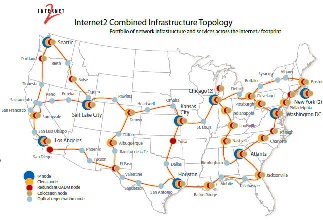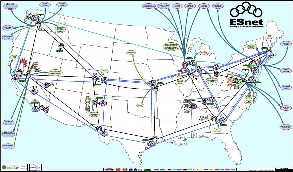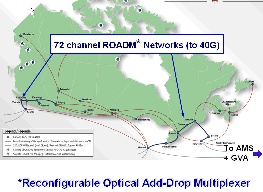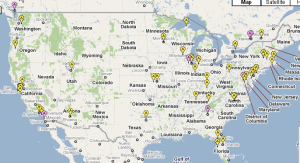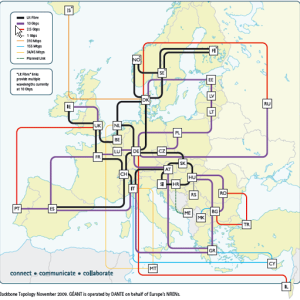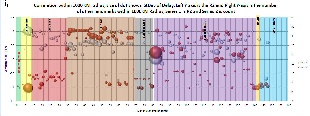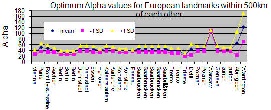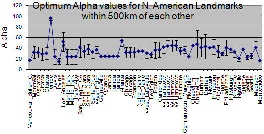We looked at plots of RTT vs Distance for pairs of Landmarks within 25ms and 1000km radii for Europe and N. America. Typically a formula of the form distance = alpha * RTT is used to derive the distance from the measured RTT. Typical values of alpha are 40 km/ms. However the value of alpha can vary dramatically based on the route the cable takes versus teh great circle distance. Fior example from the US to Japan the route is pretty direct leading to high values of alpha. However from Europe to Japan the route today goes West around the bay of Biscay, through the Mediterranean and the Red Sea, South of India, then passes via Singapore and North up the East coast of Asia to Japan. This result in smaller values of alpha. There are plans afoot to provide more direct routes via the Arctic Ocean.
When we measured the RTTs between landmarks of known location and derived the values of alpha, Europe seemed better behaved. We looked at the network topology for the major Academic and Research (A&R) networks in N. America, i.e. Internet2, ESnet and Canarie. They are shown below.
Internet2 | ESnet | Canarie | Landmarks |
|---|---|---|---|
| |
| |
We also looked at the European Academic and Research network GEANT, together with the Landmark locations in Europe. See below:
GEANT | European landmarks |
|---|---|
| |
The worldwide cable routes can be see:
- For Level3
- For African submarine cables
- For African land cables
- Telegeography world wide submarine cable map
Our initial results depict better (less variability in alpha, density of landmarks (i.e. number of landmarks with the designated radius of each other), and correlation between RTT and distance) intra regional connectivity in Europe than in North America. Both North America and Europe have many n*Gigabits links connecting one state to another in N.America or one country to another in Europe. We wish to see the state of connectivity of landmarks within a few hundred miles radius around each target landmark since these are the landmarks that are most likely to be used in the eventual algorithm.
In our analysis first we calculated the correlation coefficient for all landmarks within 1000 km (620 miles) and 25 msec. radii (assuming an alpha of 40 km/ms) around them. Below are the two graphs:
Plot within 1000 KM Distance Radius | Plot within 25 MS Delay Radius |
|---|---|
|
|
There are two series in each graph, white balls represent the Correlation coefficient and red balls represent the number of target landmark available within the chosen radius of each landmark (1000km or 25ms). The size of the ball represent the standard deviation of delay associated with each landmark and X-axis represents the ID of the landmark or simply the row number of the spread sheet of raw data. You can find spread sheets of 1000KM_Radius and 25MS_Radius correlation_coefficient_1000km_radius.xlsx and Correlation_Coefficient_25MS_Radius.xlsx(25MS file has the column names). The left-hand (Y-axis) is the Correlation coefficient value and right-hand Y-axis is the number of landmarks within the radius. As you can clearly see the trend of number of adjacent landmarks and correlation coefficient are both high for the whole of Europe but they are more dispersed thoughout North America. These results contradict the perception of very good connectivity inside North America. Thus, we decided to do further testing of this finding.
We then took the raw data of some landmark from Europe and North America again within a radii of 1000 kmand 25 ms and plotted delay to distance graphs, we see a similar trend. Below are some sample graphs.
European Landmarks | North American Landmarks |
|---|---|
| |
| |
All these graphs have delay on X-axis and distance on X-axis and in all graphs with filtered caption we have applied the median filter on the values based upon delay. This was just to see the impact of removing the sensitivity to outliers. In this case outliers are those delay values which are not following the trend. E.g. if there are three distance values 400,500,600,700 and their corresponding delay values 10,12,50,17. Here 50 is clearly an outlier. As you can observe a linear increasing trend in European landmarks which is almose absent in North American nodes. This again is depicting a similar observation that Europe has more direct links in contrast to North America. Raw data is available here, Nashville_NA.rar,Atlanta_NA.rar,Paris_France.rar,Darmstadt_Germany.rar.
Optimum Alpha Values for Europe and N. America
If we define the optimum value of alpha = alpha(opt) such that the
known distance between a landmark and target = alpha(opt) * min_RTT *100 km.
then for all landmarks within say 500km of each other we can measure the min_RTT each landmark to each other landmark (target) and find the average and standard deviations for each landmark. We did this for Europe and N. America and plots of alpha(opt) vs landmark for landmarks within 500km of each other are shown below in plots from the eu-na-opt-aplha.xlsx spreadsheet. For Europe it is seen that landmarks on the periphery such as the UK and Poland have larger values of Alpha. Possibly this is since there is less meandering on the longer distance links.
|
|
We are still investigating the above observations against the Intra-State connectivity in North America and through other statistical analysis.
New Graph correlation_coefficient_1000_old.xls
